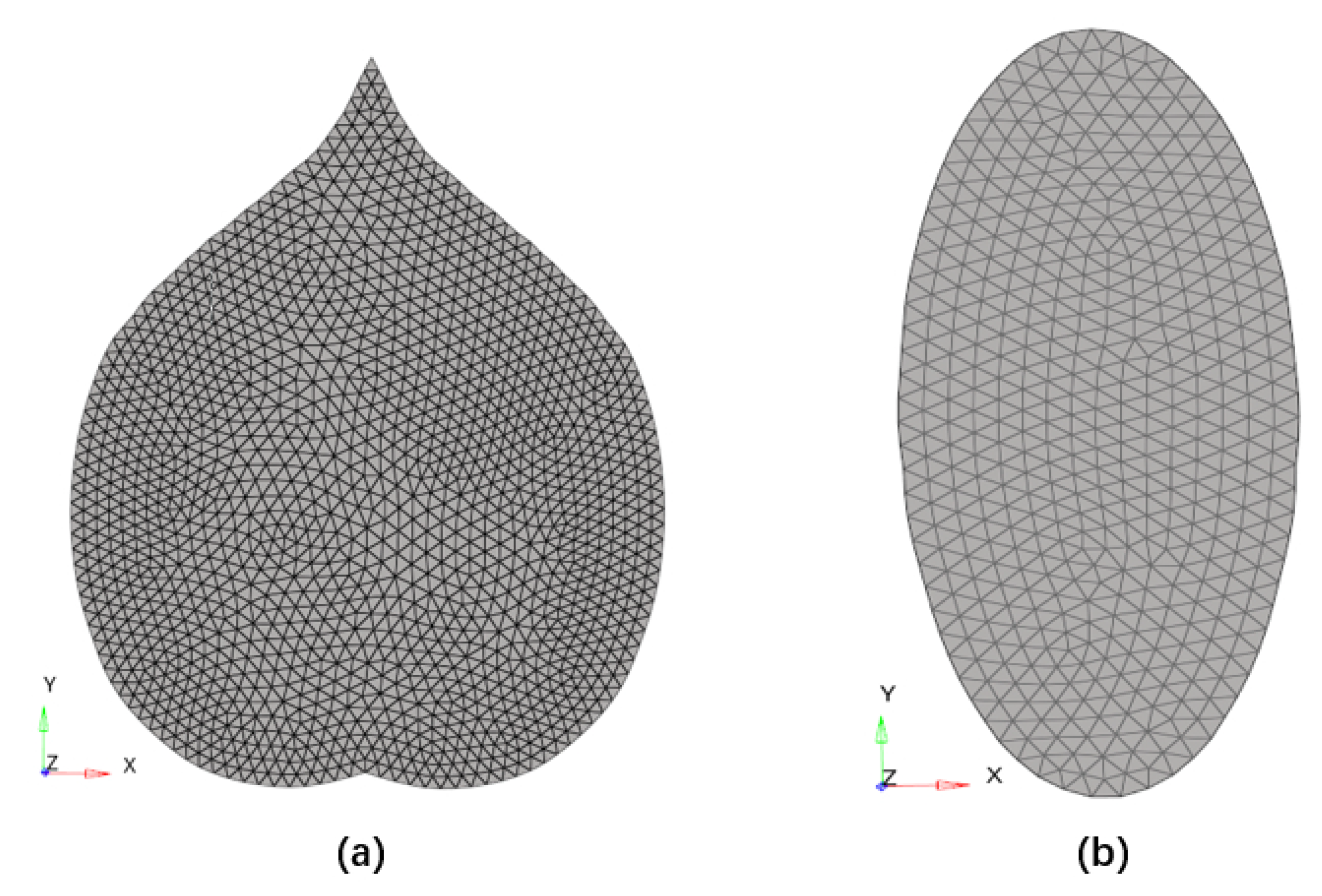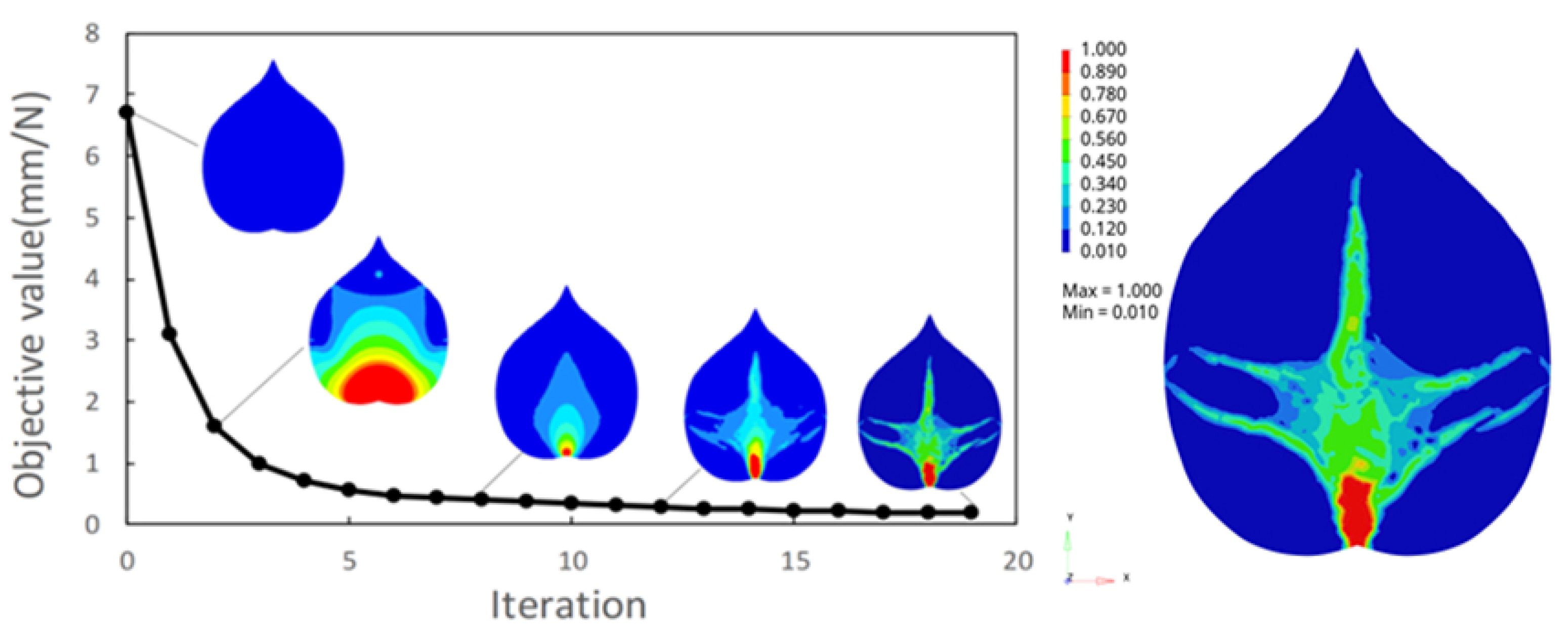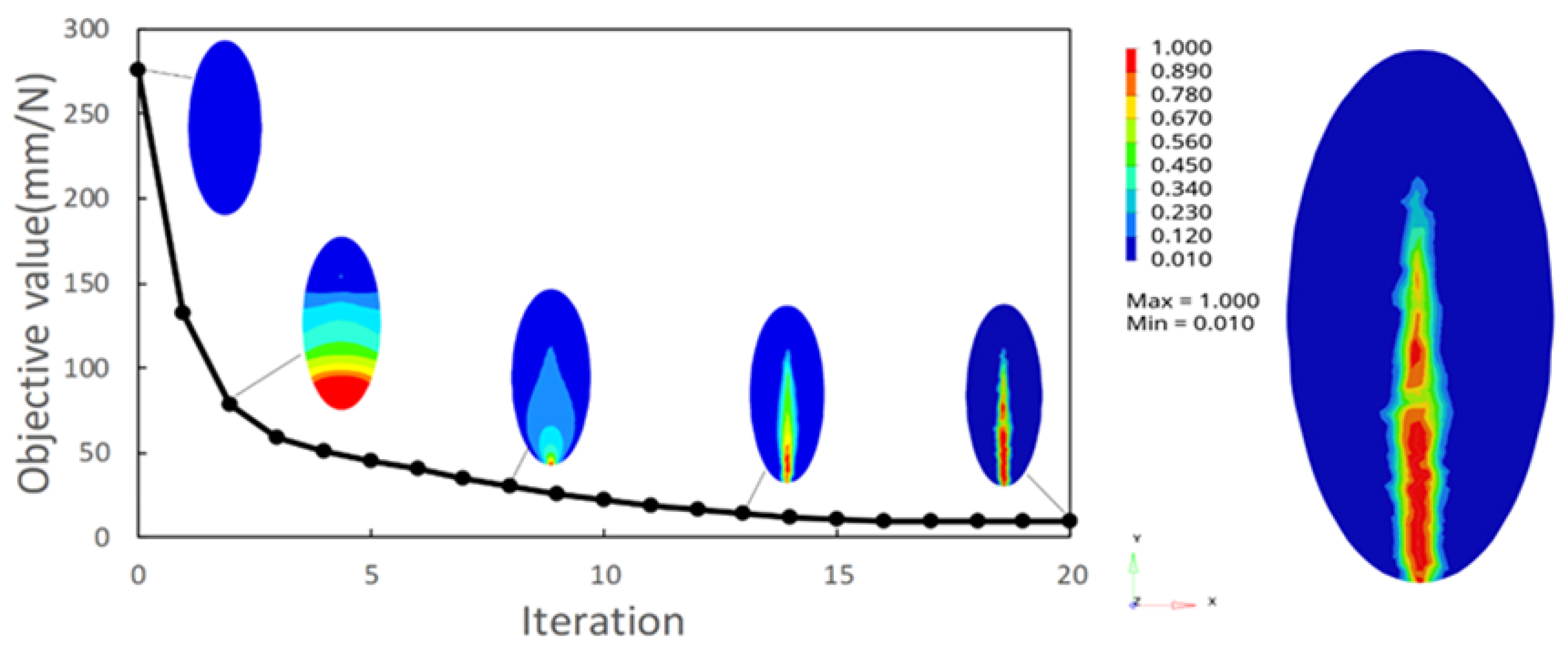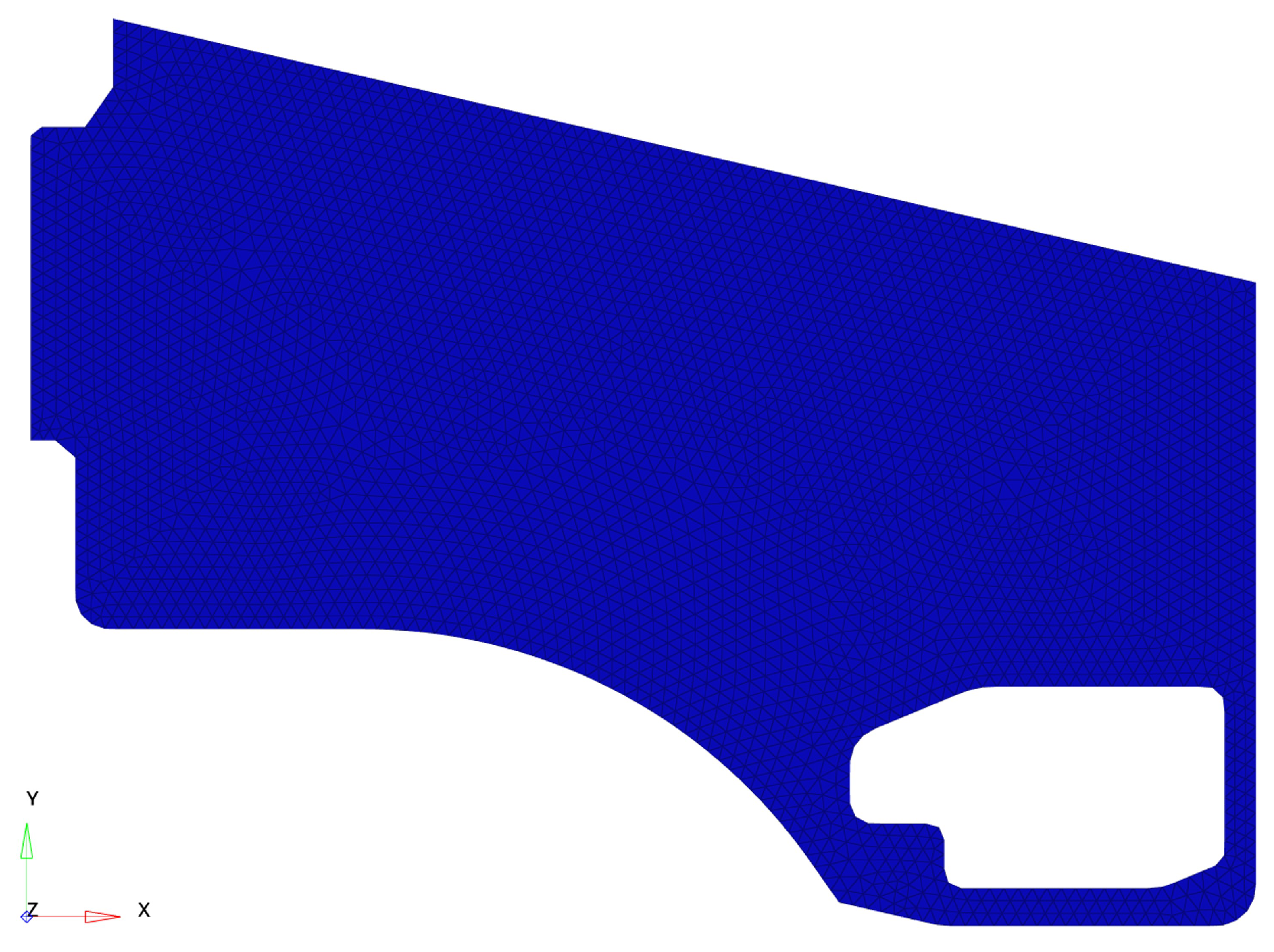Rib Reinforcement Bionic Topology Optimization under Multi-Scale Cyclic Excitation
Abstract
1. Introduction
- (1)
- Considering the leaf vein mechanical properties and structural composition, bionic topology optimization with minimum compliance and the maximum strain energy is proposed.
- (2)
- The proposed method was applied to the design of reinforcement ribs of plant leaf veins and an automotive door’s inner panel. The mechanical properties of the obtained topological configurations are superior to the original structures.
2. Bionic Vein Topology Optimization Model
3. Topology Optimization of the Veins
3.1. Conditions of Topology Optimization
3.2. Bionic Topology Optimization of the Blade Veins
4. Bionic Topology Optimization of Automotive Door’s Inner Panel
5. Conclusions
Author Contributions
Funding
Data Availability Statement
Acknowledgments
Conflicts of Interest
References
- Li, X.J.; Di, H.B.; Yang, F.X. System Reliability of reinforced concrete ribbed arch bridge. Int. J. Robot. Autom. 2021, 36. [Google Scholar] [CrossRef]
- Ma, H.W.; Zheng, H.; Zhang, W.; Tang, Z.Z. Experimental and numerical study of mechanical properties for the double-ribbed reinforced beam-column connection. Adv. Steel Constr. 2020, 16, 297–309. [Google Scholar]
- Basri, E.I.; Mustapha, F.; Sultan, M.T.H.; Basri, A.A.; Abas, M.F.; Majid, M.S.A.; Ahmada, K.A. Conceptual design and simulation validation based finite element optimisation for tubercle leading edge composite wing of an unmanned aerial vehicle. J. Mater. Res. Technol. 2019, 8, 4374–4386. [Google Scholar] [CrossRef]
- Tang, J.; Zhou, Z.P.; Chen, H.; Wang, S.Y.; Gutierrez, A.; Zhang, C.; Deng, J.K. Laminate design, optimization, and testing of an innovative carbon fiber-reinforced composite sandwich panel for high-speed train. Polym. Compos. 2021, 42, 5811–5829. [Google Scholar] [CrossRef]
- Junqueira, D.M.; Gomes, G.F.; Silveira, M.E.; Ancelotti, A.C. Design optimization and development of tubular isogrid composites tubes for lower limb prosthesis. Appl. Compos. Mater. 2019, 26, 273–297. [Google Scholar] [CrossRef]
- Liu, X.; Wang, X.; Xie, K.Y.; Wu, Z.S.; Li, F. Bond behavior of basalt fiber-reinforced polymer bars embedded in concrete under monotensile and cyclic loads. Int. J. Concr. Struct. Mater. 2020, 14, 19. [Google Scholar] [CrossRef]
- Zhu, J.S.; Guo, X.Y.; Kang, J.F.; Duan, M.H.; Wang, Y.G. Experimental investigation of flexural behavior of steel-UHPC composite beam with Waffle slab system. J. Bridge Eng. 2021, 26, 04021011. [Google Scholar] [CrossRef]
- Chen, L.J.; Su, R.K.L. Influence of rebar geometry on the steel-concrete interface of reinforced concrete. Constr. Build. Mater. 2021, 304, 124668. [Google Scholar] [CrossRef]
- Kim, S.H.; Batbold, T.; Shah, S.H.A.; Yoon, S.; Han, O. Development of shear resistance formula for the Y-type perfobond rib shear connector considering probabilistic characteristics. Appl. Sci. 2021, 11, 3877. [Google Scholar] [CrossRef]
- Zhang, B.; Zhu, H.; Wu, G.; Wang, Q.; Li, T. Improvement of bond performance between concrete and CFRP bars with optimized additional aluminum ribs anchorage. Constr. Build. Mater. 2020, 241, 118012. [Google Scholar] [CrossRef]
- Jakubovskis, R.; Kaklauskas, G. Bond-stress and bar-strain profiles in RC tension members modelled via finite elements. Eng. Struct. 2019, 194, 138–146. [Google Scholar] [CrossRef]
- Robl, T.; Wolfle, C.H.; Hameed, M.Z.S.; Rappl, S.; Krempaszky, C.; Werner, E. An approach to predict geometrically and thermo-mechanically induced stress concentrations in ribbed reinforcing bars. Metals 2022, 12, 411. [Google Scholar] [CrossRef]
- Wang, X.W.; He, Q.X.; An, Z.W.; Liu, G.J.; Wen, X.K.; Wang, Y.Q.; Zhong, Z.X. Experimental study of perfobond rib shear connector under lateral force. Appl. Sci. 2021, 11, 9088. [Google Scholar] [CrossRef]
- Peng, H.Y.; Avadh, K.; Nagai, K. Analysis of non-uniform local strain in corroded reinforcing bar in concrete using digital image correlation. J. Adv. Concr. Technol. 2023, 21, 42–57. [Google Scholar] [CrossRef]
- Zhang, P.; Zhang, S.Q.; Gao, D.Y.; Dong, F.; Liu, Y.; Zhao, J.; Scheikh, S.A. Influence of rib parameters on mechanical properties and bond behavior in concrete of fiber-reinforced polymer rebar. J. Adv. Struct. Eng. 2021, 24, 196–208. [Google Scholar] [CrossRef]
- Choi, O.C.; Yang, S.Y.; Choi, H. Splice strength of reinforcing bars with high and low alternating ribs. ACI Struct. J. 2020, 117, 177–189. [Google Scholar]
- Wang, Q.N.; Qian, C.F.; Wu, Z.W. Research on the rational design method of strength reinforcement for thin-walled structure based on limit load analysis. Appl. Sci. 2022, 12, 2208. [Google Scholar] [CrossRef]
- Jiang, X.D.; Hou, W.D.; Liu, C.; Du, Z.L.; Zhang, X.Y.; Li, X.; Guo, X. Explicit layout optimization of complex rib-reinforced thin-walled structures via computational conformal mapping (CCM). Comput. Method. Appl. Mech. Eng. 2023, 404, 115745. [Google Scholar] [CrossRef]
- Chen, L.J.; Liang, K.; Shan, Z.W. Experimental and theoretical studies on bond behavior between concrete and FRP bars with different surface conditions. Compos. Struct. 2023, 309, 116721. [Google Scholar] [CrossRef]
- Dara, A.; Bahubalendruni, M.V.A.R.; Mertens, A.J. Does topology optimization exist in nature? Natl. Acad. Sci. Lett. 2022, 45, 69–73. [Google Scholar] [CrossRef]
- Li, B.T.; Hong, J.; Yan, S.N.; Liu, Z.F. Multidiscipline topology optimization of stiffened plate/shell structures inspired by growth mechanisms of leaf veins in nature. Math. Probl. Eng. 2013, 2013, 653895. [Google Scholar] [CrossRef]
- Azikov, N.S.; Zinin, A.V.; Alipov, A.E.; Kosarev, V.A. Effective application of an anisogrid composite to design the components of the aircraft wing structure. J. Mach. Manuf. Reliab. 2022, 50, 523–531. [Google Scholar] [CrossRef]
- Cai, J.X.; Ma, Y.B.; Deng, Z.C. On the effective elastic modulus of the ribbed structure based on Schwarz Primitive triply periodic minimal surface. Thin-Walled Struct. 2022, 170, 108642. [Google Scholar] [CrossRef]
- Nasab, F.F.; Geijselaers, H.J.M.; Baran, I.; Akkerman, R.; de Boer, A. Optimization of the interacting stiffened skins and ribs made of composite materials. AIAA J. 2020, 58, 1836–1850. [Google Scholar] [CrossRef]
- Kalgutkar, A.P.; Banerjee, S.; Rajanna, T. Optimum arrangement of stiffener on the buckling behaviour of stiffened composite panels with reinforced elliptical cutouts subjected to non-uniform edge load. Steel Compos. Struct. 2022, 42, 427–446. [Google Scholar]
- Jia, L.G.; Bi, R.; Lang, Y.X.; Li, X.F. Experimental study and theoretical analysis on seismic performance of castellated beam with hexagonal holes. Adv. Steel Constr. 2020, 16, 233–245. [Google Scholar]
- Chui, B.W.; Wright, N.J.; Ly, J.; Maginnis, D.A.; Haniff, T.M.; Blaha, C.; Fissell, W.H.; Roy, S. A scalable, hierarchical rib design for larger-area, higher-porosity nanoporous membranes for the implantable bio-artificial kidney. J. Microelectromech. Syst. 2020, 29, 762–768. [Google Scholar] [CrossRef]
- Kondakov, I.O.; Chernov, A.V.; Shanygin, A.N.; Sapozhnikov, S.B. Protection of aircraft lattice shell made of UD CFRP ribs from low-velocity impacts. Mech. Compos. Mater. 2022, 57, 721–730. [Google Scholar] [CrossRef]
- Kloska, T.; Fang, X.F. Lightweight chassis components-the development of a hybrid automotive control arm from design to manufacture. Int. J. Automot. Technol. 2021, 22, 1245–1255. [Google Scholar] [CrossRef]
- Liang, K.X.; Zhu, D.C.; Li, F. Macro-microscale topological design for compliant mechanisms with special mechanical properties. Comput. Methods Appl. Mech. Eng. 2023, 408, 115970. [Google Scholar] [CrossRef]
- Lopez, E.C.; Casino, E.S.; Escribano, J.F.; Urena, A.V. Application of finite element method to create a digital elevation model. Mathematics 2023, 11, 1522. [Google Scholar] [CrossRef]
- Liang, K.X.; Zhu, D.C.; Liu, J. Topology optimization of a spatial compliant parallel mechanism based on constant motion transmission characteristic matrix. Mech. Mach. Theory 2022, 180, 105125. [Google Scholar] [CrossRef]
- Fonseca, J.H.; Quagliato, L.; Yun, S.; Han, D.; Kim, N.; Lee, H. Preliminary design of an injection-molded recycled-carbon fiber-reinforced plastic/metal hybrid autmotive structure via combined optimization techniques. Struct. Multidiscip. Optim. 2021, 64, 2772–2788. [Google Scholar] [CrossRef]
- Nguyen, T.N.; Dang, L.M.; Lee, J.; Nguyen, P.V. Load-carrying capacity of ultra-thin shells with and without CNTs reinforcement. Mathematics 2022, 10, 1481. [Google Scholar] [CrossRef]
- Abdulhameed, A.A.; Al-Zuhairi, A.H.; Al Zaidee, S.R.; Hanoon, A.N.; Al Zand, A.W.; Hason, M.M.; Abdulhameed, H.A. The behavior of hybrid fiber-reinforced concrete elements: A new stress-strain model using an evolutionary approach. Appl. Sci. 2022, 12, 2245. [Google Scholar] [CrossRef]
- Fan, Z.X.; Ye, G.Y.; Li, S.; Bai, Z.Y.; Yong, Q.W.; Zhang, Y.H.; Hu, Y.C. Compression performance and failure mechanism of honeycomb structures fabricated with reinforced wood. Structures 2023, 48, 1868–1882. [Google Scholar] [CrossRef]
- Kang, J.H.; Lee, J.W.; Kim, J.H.; Ahn, T.M.; Ko, D.C. Design of center pillar with composite reinforements using hybrid molding method. Materials 2021, 14, 2047. [Google Scholar] [CrossRef]
- Mahendrakumar, N.; Thyla, P.R.; Mohanram, P.V.; Kumaran, C.R.; Jayachandresh, J. Study on static and dynamic characteristics of nettle-polyester composite micro lathe bed. Proc. Inst. Mech. Eng. Part L J. Mater. Des. Appl. 2019, 233, 141–155. [Google Scholar] [CrossRef]
- Heckadka, S.S.; Nayak, S.Y.; Kamath, C.R.; Adarsh, S.P.; Samant, R. Characterizaion of a novel polyalthia longifolia mid-rib fibers as a potential reinforcement for polymer composites. J. Nat. Fibers 2022, 19, 2106–2118. [Google Scholar] [CrossRef]
- Chernyshev, S.L.; Dubovikov, E.A.; Ionov, A.A.; Kondakov, I.O.; Shanygin, A.N.; Zichenkov, M.C. Basic principles for creating light, efficient and safe structures for the next generation supersonic transport. Acta Astronaut. 2023, 204, 728–737. [Google Scholar] [CrossRef]
- Rivas-Padilla, J.R.; Boston, D.M.; Boddapati, K.; Arrieta, A.F. Aero-structural optimization and actuation analysis of a morphing wing section with embedded selectively stiff bistable elements. J. Compos. Mater. 2023, 57, 737–757. [Google Scholar] [CrossRef]
- Martinez, X.; Pons-Prats, J.; Turon, F.; Coma, M.; Barbu, L.G.; Bugeda, G. Multi-objective multi-scale optimization of composite structures, application to an aircraft overhead locker made with bio-composites. Mathematics 2023, 11, 165. [Google Scholar] [CrossRef]
- Hu, J.K.; Xu, P.; Fan, Z.Q.; Li, Y.Z.; Tan, X.L. Axial compression response of multi-cell tube reinforced by parallel leaf veins inspired secondary ribs. Thin-Walled Struct. 2023, 185, 110557. [Google Scholar] [CrossRef]
- Manzoor, S.; Din, I.U.; Giasin, K.; Koklu, U.; Khan, K.A.; Panier, S. Three-dimensional finite element modeling of drilling-induced damage in S2/FM94 glass-fiber-reinforced polymers (GFRPs). Materials 2022, 15, 7052. [Google Scholar] [CrossRef]
- Shen, L.; Ding, X.H.; Hu, T.N.; Zhang, H.; Xu, S.P. Simultaneous optimization of stiffener layout of 3D box structure together with attached tuned mass dampers under harmonic excitations. Struct. Multidiscip. Optim. 2021, 64, 721–737. [Google Scholar] [CrossRef]
- Yi, M.R.; Wu, L.T.; Liu, L.Q.; Zhang, P.X.; Li, X.B. Research on the typical microstructures and contact angles of hydrophobic plant leaves. Micro Nano Lett. 2020, 15, 250–254. [Google Scholar] [CrossRef]









| Heart-Shaped Blade Vein | Elliptic Blade Vein | |
|---|---|---|
| Before Optimization | ||
| After Optimization | ||
| Increase |
| Density () | Elasticity Modulus () | Poisson’s Ratio () | Strength of Extension () |
|---|---|---|---|
| 2.70 | 70.00 | 0.27 | 227.00 |
| Conditions | Anti-Concave Condition () | Sinking Condition () |
|---|---|---|
| Original | 177.30 | 185.00 |
| Bionic | 174.80 | 117.00 |
Disclaimer/Publisher’s Note: The statements, opinions and data contained in all publications are solely those of the individual author(s) and contributor(s) and not of MDPI and/or the editor(s). MDPI and/or the editor(s) disclaim responsibility for any injury to people or property resulting from any ideas, methods, instructions or products referred to in the content. |
© 2023 by the authors. Licensee MDPI, Basel, Switzerland. This article is an open access article distributed under the terms and conditions of the Creative Commons Attribution (CC BY) license (https://creativecommons.org/licenses/by/4.0/).
Share and Cite
Xiao, Z.; Wu, L.; Zhu, D.; Wu, W.; Zhang, C.; Li, F. Rib Reinforcement Bionic Topology Optimization under Multi-Scale Cyclic Excitation. Mathematics 2023, 11, 2478. https://doi.org/10.3390/math11112478
Xiao Z, Wu L, Zhu D, Wu W, Zhang C, Li F. Rib Reinforcement Bionic Topology Optimization under Multi-Scale Cyclic Excitation. Mathematics. 2023; 11(11):2478. https://doi.org/10.3390/math11112478
Chicago/Turabian StyleXiao, Zhongmin, Longfei Wu, Dachang Zhu, Wenqiang Wu, Chunliang Zhang, and Fangyi Li. 2023. "Rib Reinforcement Bionic Topology Optimization under Multi-Scale Cyclic Excitation" Mathematics 11, no. 11: 2478. https://doi.org/10.3390/math11112478
APA StyleXiao, Z., Wu, L., Zhu, D., Wu, W., Zhang, C., & Li, F. (2023). Rib Reinforcement Bionic Topology Optimization under Multi-Scale Cyclic Excitation. Mathematics, 11(11), 2478. https://doi.org/10.3390/math11112478







